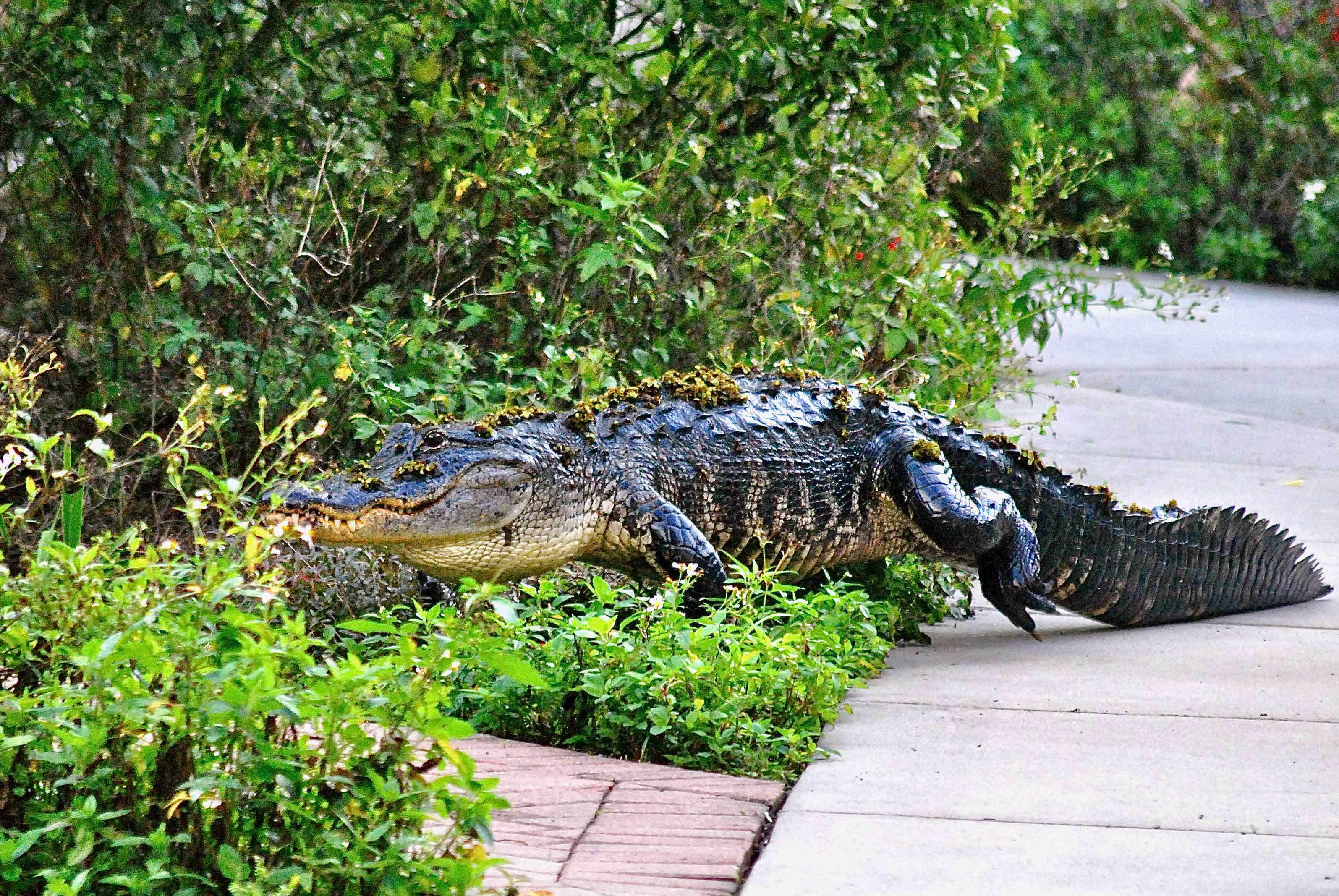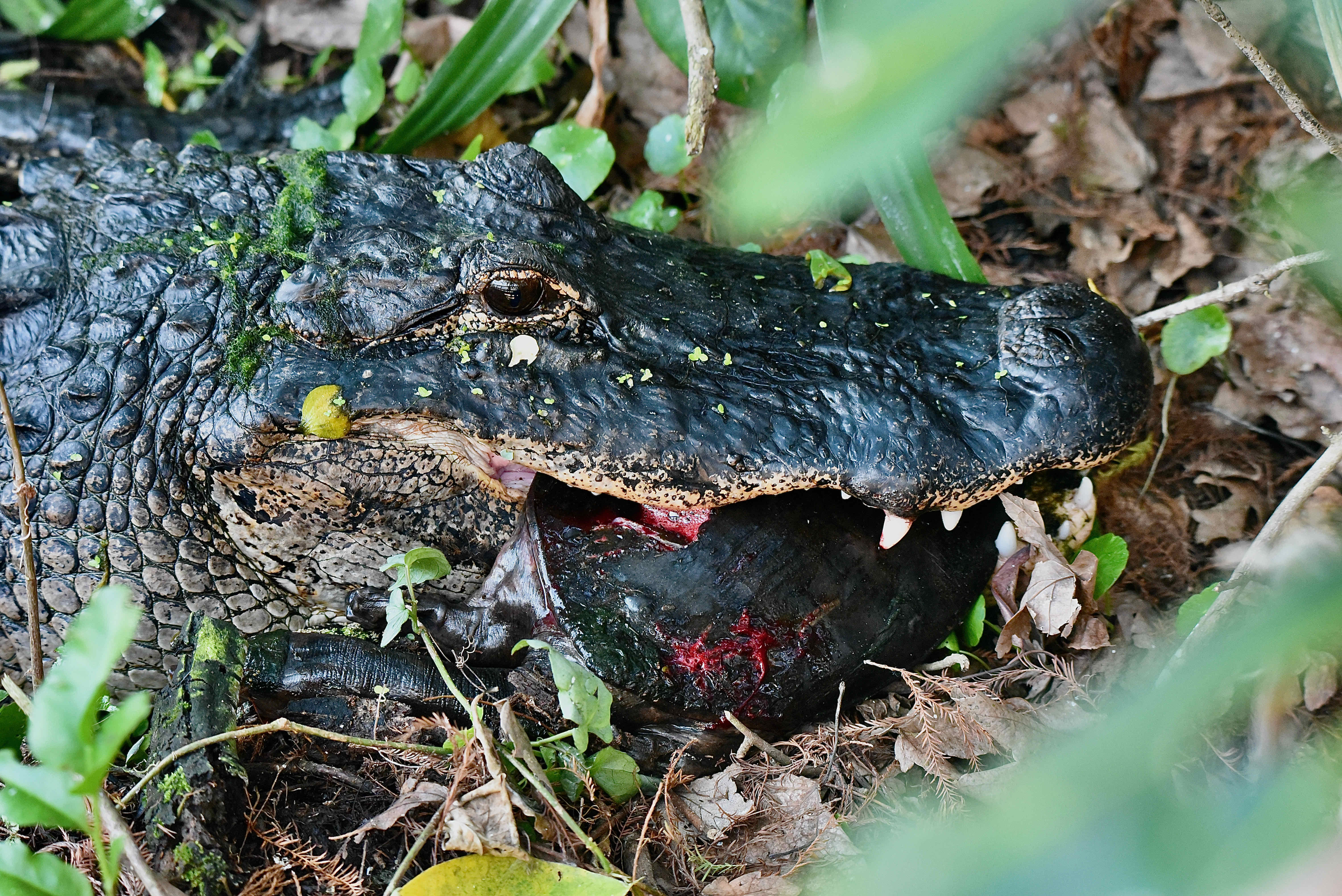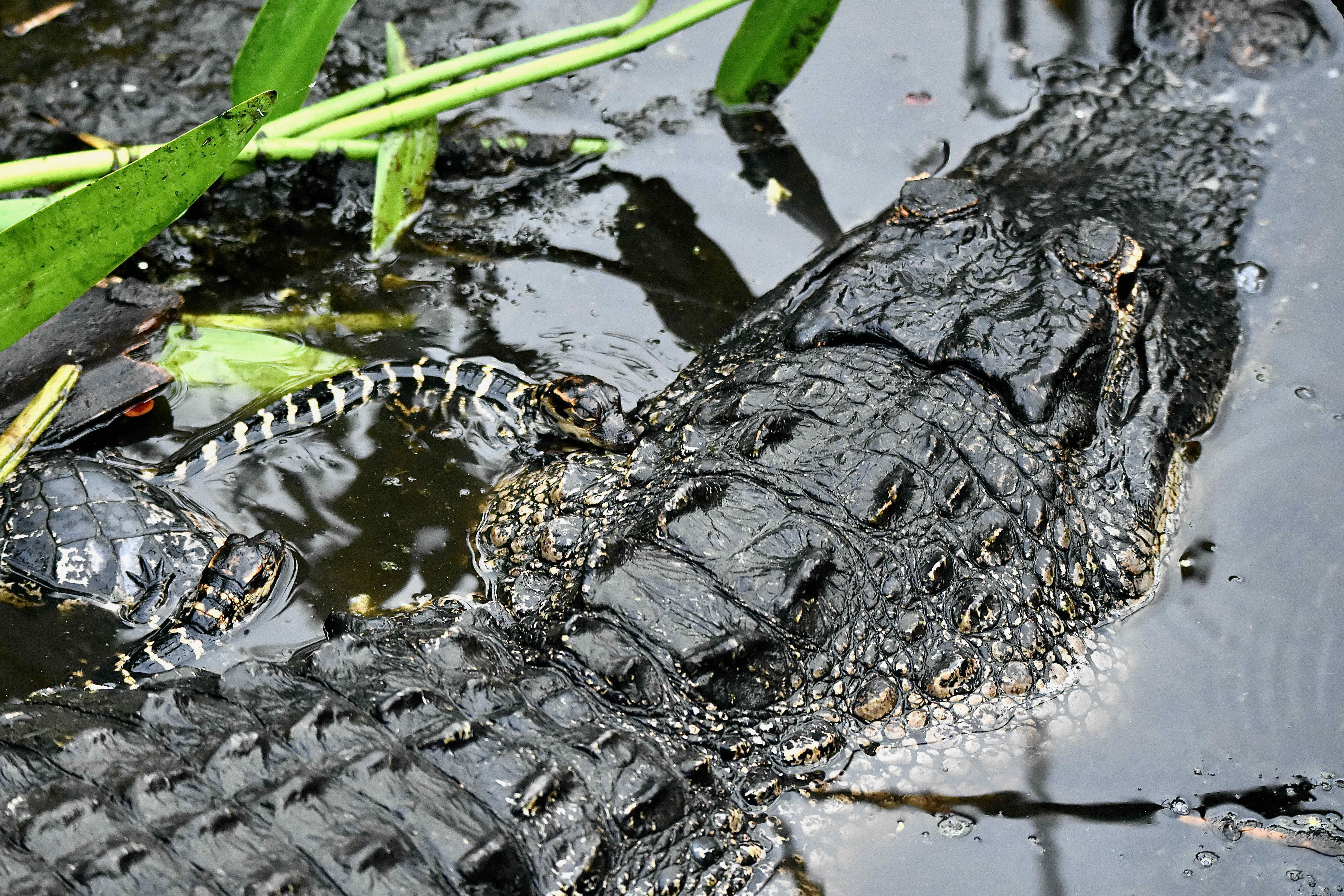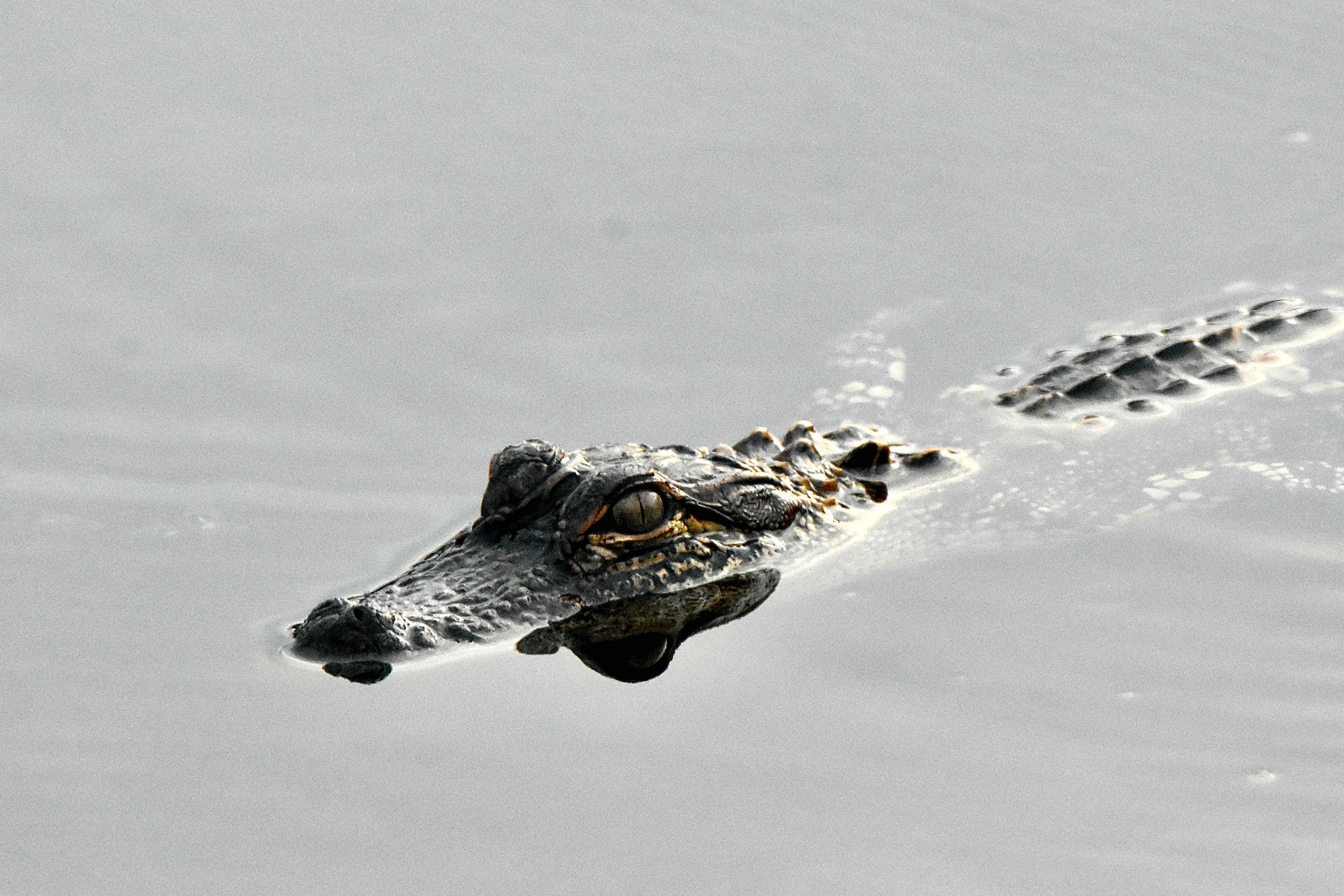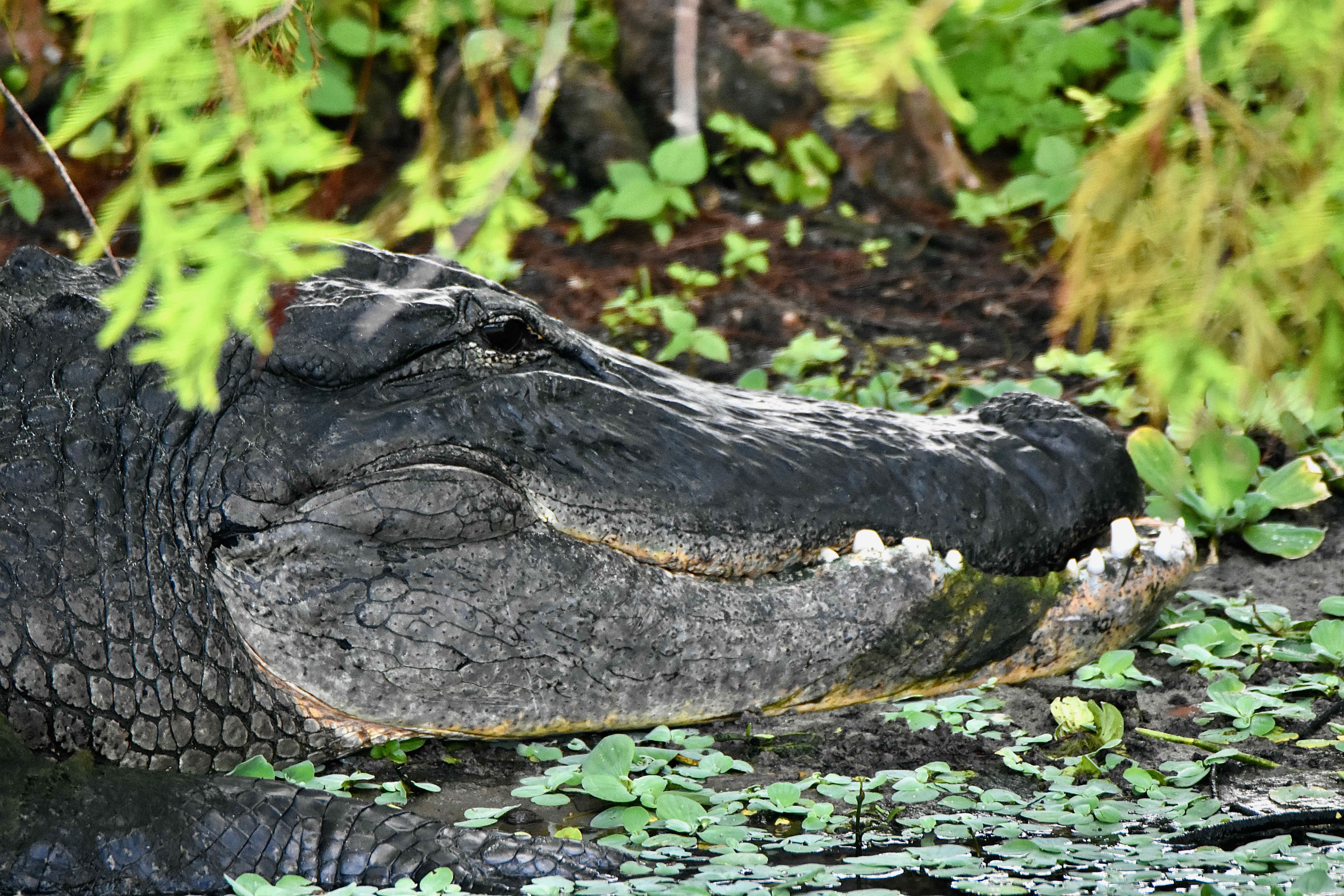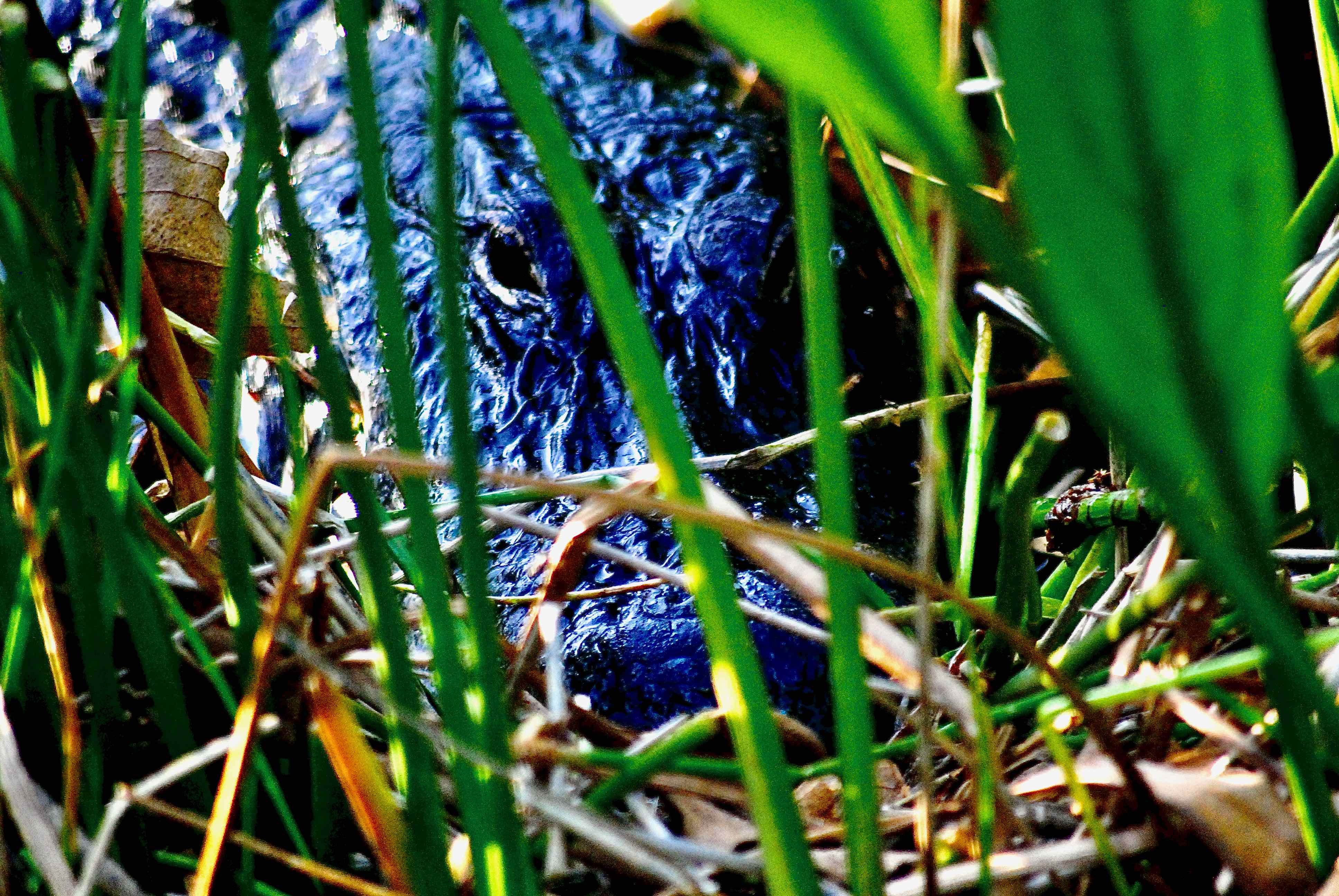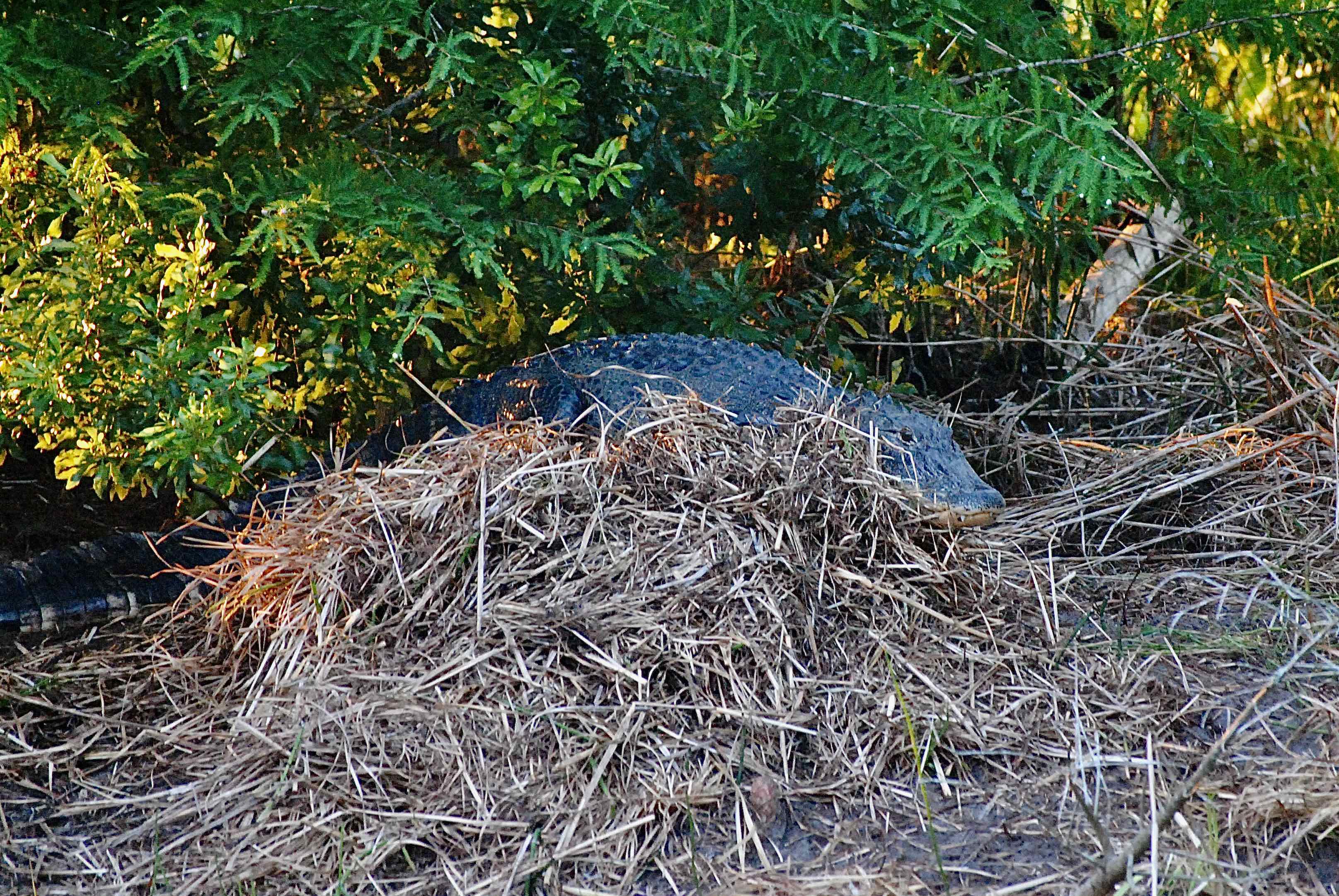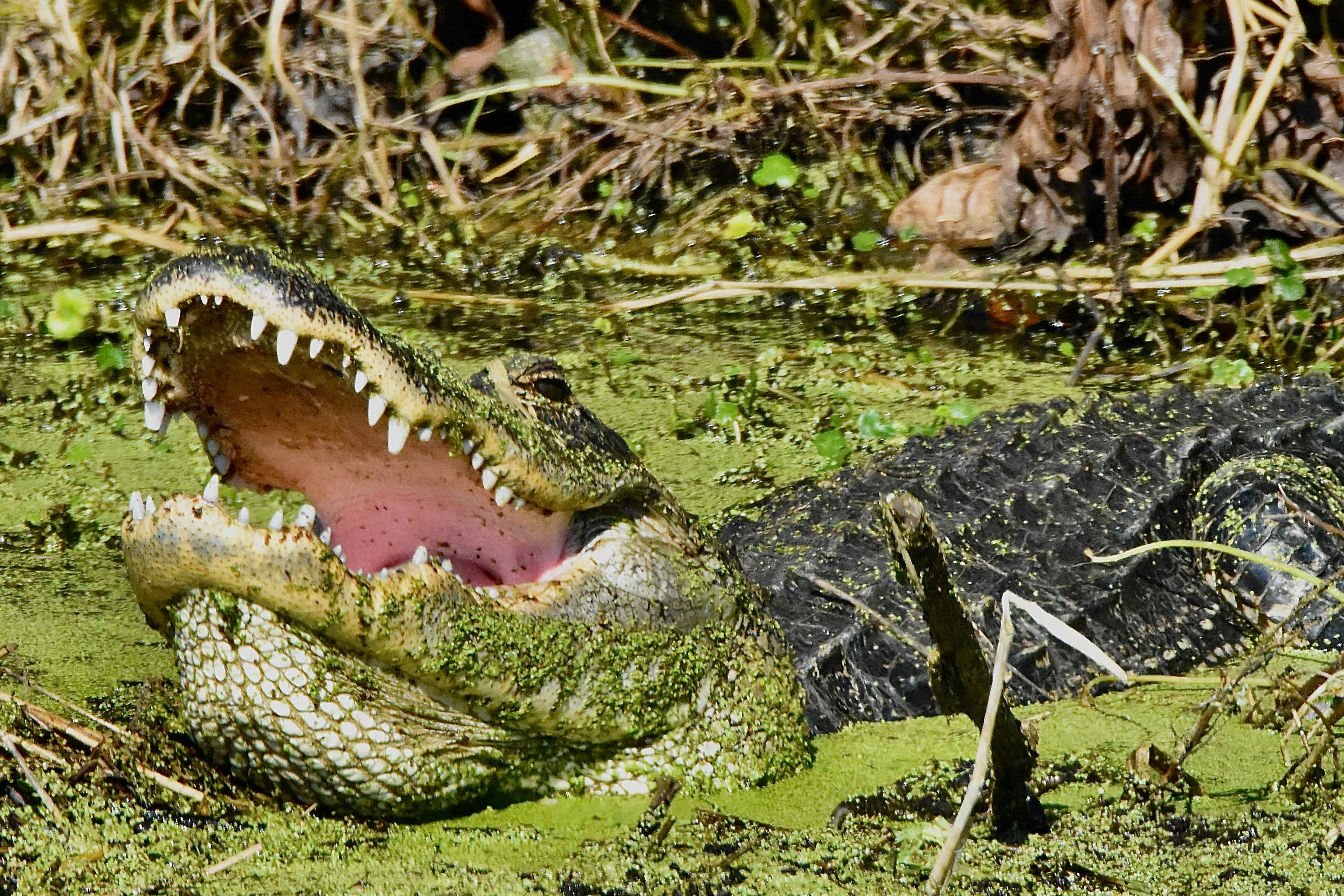
American alligator, photographed at Loxahatchee National Wildlife Refuge, Boynton Beach, Palm Beach County, in March 2018.
Nothing says Florida more than the alligator, Alligator mississipiensis. It is, after all, the official reptile of the Sunshine State and the symbol of one of its flagship universities.
And for good reason. It is the top of the food chain in its part of the world. An adult gator fears no other animal except one of its kind, and of course, us. We’ve seen them eat raccoons. We’ve seen them eat bobcats. We’ve seen them eat turtles. Lots of turtles. Birds are on their menu and so is just about anything else they can get their jaws on. Thing is, most everything on their menu also depends on the alligator for their very lives, which is why some call the alligator the Guardian of the Everglades and consider it to be a keystone species. More in a bit.
An adult male can grow to 14 feet in length (Florida record: 14 feet, three-and-a-half inches) and weigh as much as a half-ton (Florida record: 1,043 pounds). Females can hit 10, but average about eight. An easy rule for estimating a gator's size: look at the distance between the eyes and the nostrils. Each inch equates to about a foot in body length.
Mid-spring is mating season. Males become extremely territorial and will butt heads and spar with any rival who might enter what they consider their turf.
To get the attention of the ladies (and warn off rivals), a guy gator will pop his head above water and bellow. But this cry for love doesn't carry all that far, so they'll also bellow underwater, which sets off vibrations that can be picked up at great distances. And gators are extremely sensitive to vibrations.
When a lady gator approaches, the two will do an elaborate dance with the male exposing his neck as a sign of good intentions. If she's in the mood, she'll follow suit and the two will make sweet love — underwater. A male will mate with any and all willing females he encounters within his territory to improve his odds of successfully passing on his genes. Some time between late May and early July, females will deposit between 20 and 60 eggs (average 38) in a mounded nest made of vegetation and soil. The decomposing plant stuff helps keep the eggs warm, which is important beyond the obvious because temperature will determine the sex of the hatchlings. Eggs kept at 90 to 93 degrees will be males; 82 to 86 degrees, females. (One potential consequence of global warming: more males, fewer females, not only of gators but other reptilian egg-laying species where sex is determined by nest temperatures.)
Mom will aggressively guard the nest from anything she deems a threat, including humans if they approach. We've seen a female gator grab and toss encroaching turtles off her nest. The turtles presumably were attempting to lay their own eggs in the nest, a dangerous, though logical practice. Two months later, August or September, the eggs hatch, the young gators being less than a foot long and pretty much defenseless. The mother will watch over her brood for about a year, warding off marauding birds, raccoon and other gators (Yes, dad is a threat to his offspring).
But even with mom's protection, the odds are long against a hatchling reaching maturity. Out of a brood of eight to 12, perhaps one or two might make it to adulthood. They will grow about a foot a year; It can take a decade or more for a gator to reach sexual maturity. By the way, a gator is considered an adult when he or she reaches six feet in length. In the wild, they can live to be 30 to 50 years old, longer in captivity.
Now and then, you’ll hear someone mistake gators for crocodiles. There are crocodiles in Florida, but they’re rare and usually don’t share the same habitat, gators preferring fresh water, crocs salt or brackish. Crocodiles also are pretty much restricted to south Miami-Dade and Monroe counties. However, gators and crocs are part of the same order, Crocodilia.
The differences between the two species aren't all that obvious but you don't have to be an expert to distinguish one from the other. Gators have a broad snout with a rounded tip, sort of like a C; crocs have a narrow snout with a blunt tip, sort of like an A. Think C for alligator, A for crocs. Also, the fourth tooth on the croc's lower jaw is fully exposed when its mouth is closed; not so on a gator. But the resemblace is close enough that the U.S. Fish and Wildlife Service lists alligators as threaten in order to protect crocs, which are endangered. By keeping gators protected, the Feds limit the chances that a croc is killed by someone who mistakes one for an alligator. The threatened status, however, enables the state to allow some restricted hunting.
There are stories about how fast alligators can move, how high they can jump. Most aren't true. They can jump and they do move quickly over short distances on land as well as in the water, but they are cold-blooded animals and they aren't going to work any harder than they have to in order to get their next meal. They're more likely to ambush prey rather than run it down.
And because they are cold-blooded, they don't need to eat nearly as much as one might think. Mammals — us humans, for example — burn fuel not only to move and function but to maintain body temperature. Gators do that by basking in the sun.
Gators attacks on humans are extremely rare but they do happen, and the possibility shouldn't be taken lightly. Anywhere there’s fresh or brackish water is a potential gator hole — always look carefully, VERY CAREFULLY, before approaching the bank of any body of water. Don't get unnecessarily close, don't harass or feed an alligator. Doing so is illegal and dangerous for both humans and alligators. (As the folks at the Florida Fish and Wildlife Conservation Commission like to say, "A fed gator is a dead gator.") Oh and if one does come after you, forget running in a zig-zag pattern as myth suggests. Instead, skidaddle as fast as you can, but in a straight line. And don't swim in any body of water where gators could be lurking. Water is their element.
Gators dig holes that will hold water during Florida’s dry season, shoveling muck out with its body and tail. Adults might use and improve the hole over a period years. These “gator holes” become important not only for the alligators but as critical habitat for fish, turtles, frogs, snakes and other animals. They become a ready source of food for the resident gator, but as we said, gators don't really eat that much compared to their size; a few of the refugees will die, but they would have died any way. And most will live to see the advent of another rainy season. Gators also will burrow into the mud banks of the hole (or any other body of water), creating a den as long as 20 feet that will shelter them through the dry season and keep them warm on cold winter nights.
More gator basics: Alligators are reptiles; scientists believe they arose from a common ancestor with dinosaurs and that they are more closely related to birds, which are descendants of dinosaurs, than they are lizards, turtles and snakes.
Alligators have four-chambered hearts, like birds and mammals, including humans, rather than the standard reptilian three-chambered heart; the advantage of a four-chambered heart is that oxygenated and deoxygenated blood are separated, allowing for more efficient breathing to maintain the high metabolism that warm-blooded animals need. Alligators are cold-blooded, however, and don't really need a four-chambered heart. In some ways, it's a disadvantage, like when they need to slow their metabolism to stay underwater for long periods of time. To overcome this, they've evolved an aortic shunt that helps mix oxygenated and deoxygenated blood. There's also a valve in the pulmonary artery that when closed forces deoxygenated blood to bypass the lungs and circulate in a way that allows for more mixing. In essence, they're able to scavenge more oxygen from each breath they take. This plays a role in their ability to stay underwater for long periods of time. How long? Interesting question.
Studies done in the 1960s found that alligators can remain underwater for as long as two hours, as the heart rate slows to two or three beats per minute; the heart itself might be the only muscle receiving oxygen, minimizing oxygen consumption. But in the wild, alligators remain underwater for much shorter periods, typically five or six minutes at a time, 15 minutes max. Those early studies were done on captive alligators in tanks under ideal circumstances — at rest and consuming minimal oxygen. In nature, a gator is only going to remain underwater for long periods if he's stressed, which means high oxygen demand. So forget two hours; an alligator will drown if kept under water for 20 or 30 minutes. On the other hand, alligators have been known to remain underwater for more than eight hours in water that's near freezing. The cold water lowers its metabolism and oxygen demand.
Other anatomical notes: alligator brains are tiny, weighing eight or nine grams. Human brains, by contrast, weight about three pounds. They have between 70 and 90 teeth in their mouths at a given time; each will be replaced as it wears down or breaks; a gator might go through as many as 1,800 teeth in a lifetime. Those boney ridges along an alligator's back help to regulate body temperature, gathering heat when a gator basks, releasing heat at other times.
Alligators are members of Alligatoridae, the alligator family. There is one other species of alligator in existence: the Chinese alligator, Alligator sinensis, which is a native of eastern China and considered critically endangered. Caimans are also classified as members of Alligatoridae. Together with crocs, they make up the order, Crocodilia. Gators can be found throughout Florida, including the Keys, and throughout the southeastern United States, from North Carolina to Texas and Oklahoma.
Photo Gallery — Click on photo for larger image
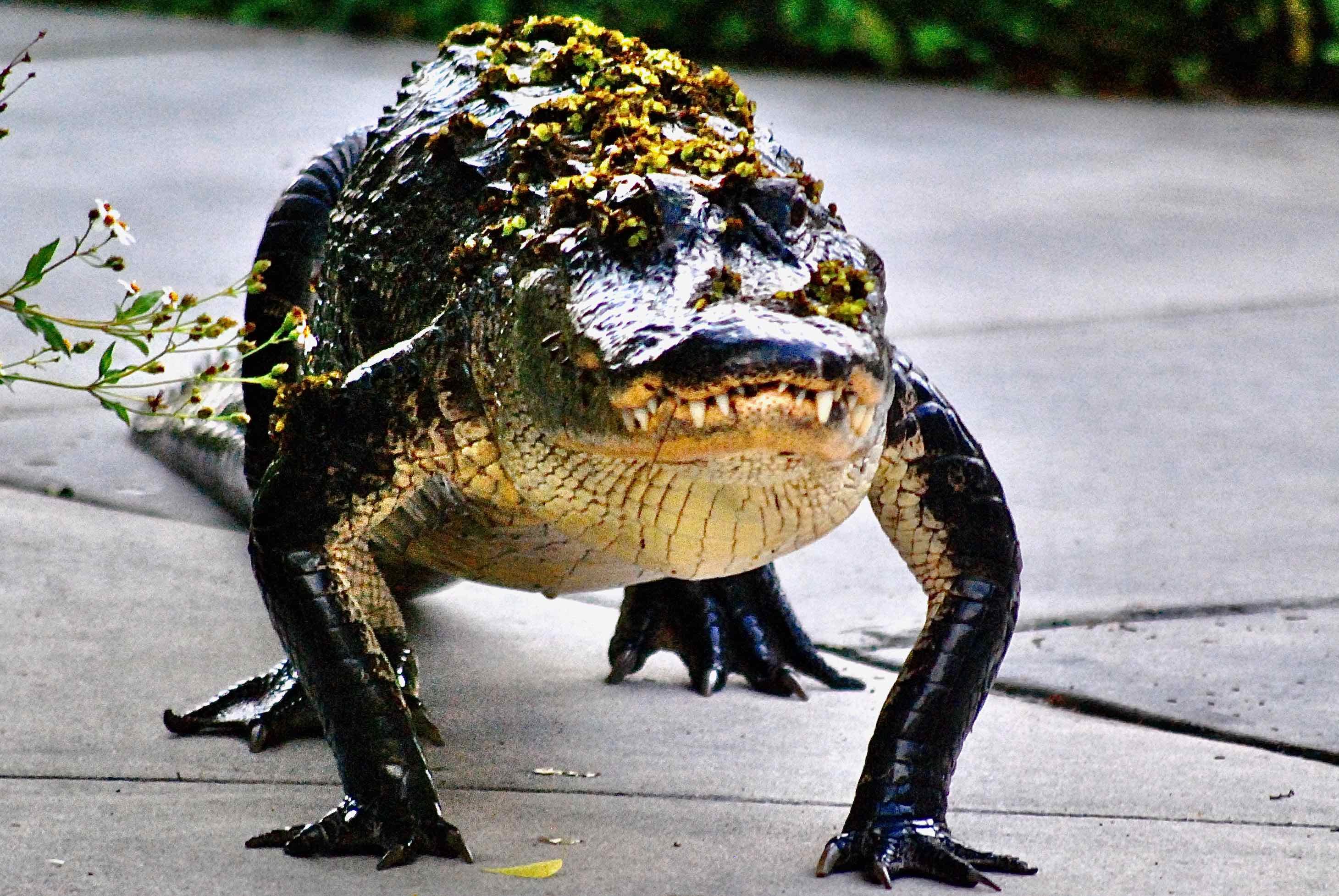
This is not a view of an alligator you particularly want to see, mere feet away and nothing but him and you, but it does reveal several things about gator anatomy. First thing, the legs are more underneath the body rather than to the side like most reptiles. This allows them to walk without dragging their bellies. The front feet have five toes, the rear only four, but they are webbed to aid in swimming.
Also note the eyes are at the side of the head (only one is really visible here because of the debris covering the one on the left). We've
read reputable sources that say alligators have poor eyesight but the University of Florida says to the contrary that they have excellent vision. And UF should know.
